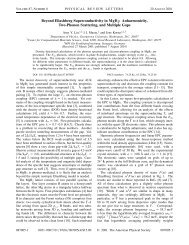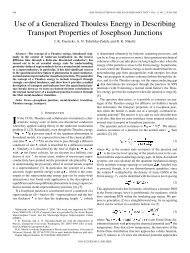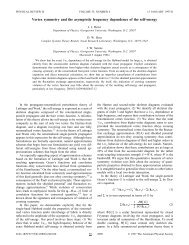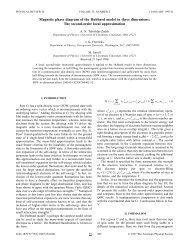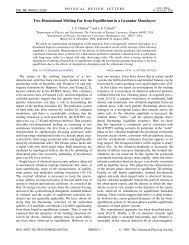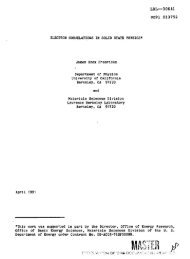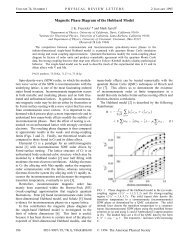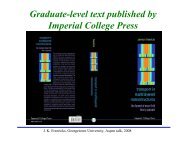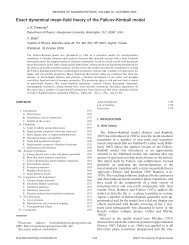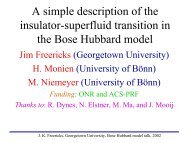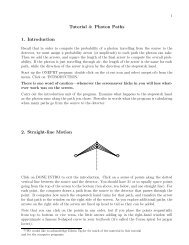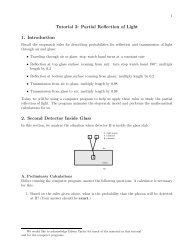Strong-coupling perturbation theory for the extended Bose-Hubbard ...
Strong-coupling perturbation theory for the extended Bose-Hubbard ...
Strong-coupling perturbation theory for the extended Bose-Hubbard ...
You also want an ePaper? Increase the reach of your titles
YUMPU automatically turns print PDFs into web optimized ePapers that Google loves.
M. ISKIN AND J. K. FREERICKS PHYSICAL REVIEW A 79, 053634 2009<br />
ins<br />
E CDW n A ,n B <br />
= U n An A −1 + n B n B −1<br />
+ zV n An B<br />
− n A + n B<br />
M<br />
4<br />
2 2<br />
n<br />
+<br />
A n B +1<br />
Un A − n B −1 + Vzn B − zn A +1 + n B n A +1<br />
Un B − n A −1 + Vzn A − zn B +1 zt2<br />
2 + Ot4 , 13<br />
which is also an extensive quantity, and <strong>the</strong> odd-order terms in t also vanish. Notice that Eq. 13 reduces to Eq. 12 when<br />
n A =n B =n 0 as expected.<br />
The calculation of <strong>the</strong> defect state energies is more involved since it requires using degenerate <strong>perturbation</strong> <strong><strong>the</strong>ory</strong>. This is<br />
because when exactly one extra particle or hole is added to <strong>the</strong> Mott phase, it could go to any of <strong>the</strong> M lattice sites and all of<br />
those states share <strong>the</strong> same energy when t=0. There<strong>for</strong>e, <strong>for</strong> both Mott-defect states with exactly one extra particle or hole, <strong>the</strong><br />
initial degeneracy is of order M and it is lifted at first order in t. A lengthy but straight<strong>for</strong>ward calculation leads to <strong>the</strong> energy<br />
of <strong>the</strong> Mott particle-defect state up to third order in t as<br />
par<br />
E Mott<br />
n 0 = E ins<br />
Mott n 0 + Un 0 + zVn 0 − − n 0 +1zt + n 0n 0 +1 1−z<br />
U<br />
n 0 z −2<br />
U 2 + z2 −3z +3 U − V 2<br />
+ 21−z<br />
U −2V +<br />
2z<br />
U − V − n 0 +2<br />
2U − Vzt 2 − n 0 n 0 +1<br />
+ n 0 +1 z1−z<br />
U 2 − 2z2 −6z +6<br />
U − V 2 + 2z1−z<br />
U −2V 2 + 2z2 −3z +3<br />
+<br />
UU − V<br />
+ 4z2 −3z +3<br />
+ n<br />
U − VU −2V 0 +2 z −1<br />
UU − V − z<br />
4U − V 2zt3 + Ot 4 .<br />
4z −2<br />
UU −2V<br />
14<br />
This expression is valid <strong>for</strong> all d-dimensional hypercubic lattices, and it recovers <strong>the</strong> known result <strong>for</strong> <strong>the</strong> on-site BH model<br />
when V=0 7,8. To third order in t, we obtain a similar expression <strong>for</strong> <strong>the</strong> energy of <strong>the</strong> Mott hole-defect state given by<br />
hol<br />
E Mott<br />
n 0 = E ins<br />
Mott n 0 − Un 0 −1 − zVn 0 + − n 0 zt + n 0 +1n 0 1−z<br />
U<br />
− n 0 n 0 +1n 0 +1 z −2<br />
U 2 + z2 −3z +3 U − V 2<br />
+ 21−z<br />
U −2V +<br />
+ 4z2 −3z +3<br />
+ n<br />
U − VU −2V 0 −1 z −1<br />
UU − V − z<br />
4U − V 2zt3 + Ot 4 ,<br />
2z<br />
U − V −<br />
n 0 −1<br />
2U − Vzt 2<br />
+ n 0 z1−z<br />
U 2 − 2z2 −6z +6<br />
U − V 2 + 2z1−z<br />
U −2V 2 + 2z2 −3z +3<br />
+<br />
UU − V<br />
4z −2<br />
UU −2V<br />
15<br />
which also is valid <strong>for</strong> all d-dimensional hypercubic lattices, and recovers <strong>the</strong> known result <strong>for</strong> <strong>the</strong> on-site BH model when<br />
V=0 7,8.<br />
On <strong>the</strong> o<strong>the</strong>r hand, <strong>for</strong> d1 dimensions, when an extra particle or hole is added to <strong>the</strong> CDW phase, it could go to any of<br />
<strong>the</strong> M /2 sites in sublattice B or A, respectively. Here, we recall that n A n B is assumed in this paper. There<strong>for</strong>e, <strong>for</strong> both<br />
CDW-defect states with an extra particle or hole in d1 dimensions, <strong>the</strong> degeneracy is of order M /2 and it is lifted at second<br />
order in t. This is because <strong>the</strong> states occupy one of <strong>the</strong> sublattices, and <strong>the</strong>y cannot be connected by one hop, but ra<strong>the</strong>r require<br />
two hops to be connected. Ano<strong>the</strong>r lengthy but straight<strong>for</strong>ward calculation leads to <strong>the</strong> energy of <strong>the</strong> CDW particle-defect state<br />
up to third order in t as<br />
par<br />
E CDW<br />
ins<br />
n A ,n B = E CDW<br />
−<br />
+<br />
n A ,n B + Un B + zVn A − +<br />
n A +1n B +1z<br />
Un B − n A + Vzn A − zn B − n A n B +1z<br />
Un A − n B −1 + Vzn B − zn A +1<br />
n B n A +1z<br />
Un B − n A −1 + Vzn A − zn B +1 + n A n B +2<br />
Un A − n B −2 + Vzn B − zn A +2 +<br />
2n A n B +1z −1<br />
Un A − n B −1 + Vzn B − zn A +2zt 2 + Ot 4 .<br />
n B n A +1z −1<br />
Un B − n A −1 + Vzn A − zn B <br />
16<br />
This expression is valid <strong>for</strong> d1-dimensional hypercubic lattices. Notice that <strong>the</strong> odd-order terms in t vanish <strong>for</strong> <strong>the</strong>se<br />
lattices. To third order in t, we obtain a similar expression <strong>for</strong> <strong>the</strong> energy of <strong>the</strong> CDW hole-defect state given by<br />
053634-4



